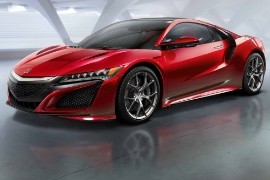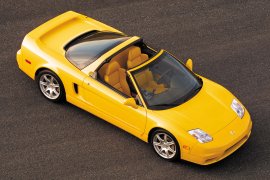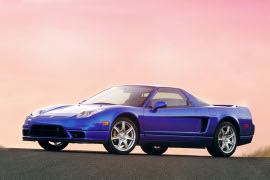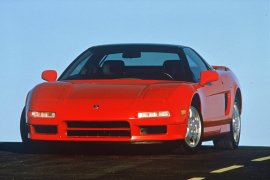ACURA NSX Models/Series Timeline, Specifications & Photos
First production year: 1991
Engines: Hybrid, Gasoline
Body style: Coupé (two-door)
The Japanese automaker didn't want to rush things before introducing a new generation for the beloved NSX nameplate, but when it did, it was, again, a revolutionary vehicle.
Unlike its famous predecessor, the 2016 NSX was not designed and conceived as a supercar-beater but more of a GT with a sportscar appearance. Depending on the market, Honda sold it under the Acura or the Honda badge, even though the main difference between them was the speedometer marked in kilometers per hour or miles per hour, respectively. But, since both versions sported a digital display, it was just a matter of software setting.
Like its predecessor, the 2016 NSX was a mid-engined car with a short nose. The styling, on the other hand, was completely different. Its angular front fascia sported slim LED headlights and a pentagonal-shaped grille flanked by broad side scoops. From its profile, the greenhouse sported an arched roofline that sloped down to the back of the vehicle, covering the engine compartment. In front of the rear wheel arches, the automaker installed the air intakes needed to cool the engine and feed it with air. Finally, at the back, Honda's design team installed LED taillights linked with a red strip.
Despite the sporty exterior look, the cabin was luxurious. Even though it featured high-bolstered seats, these provided both comfort and side support. Between the car's occupants, the automaker installed a tall center console that hosted the buttons for the gearbox. There wasn't any shift lever or gear selector. Fronting the driver was a TFT that showed the speedometer in digits inside the round tachometer.
But the real magic of the car happened under its skin, where a pair of electric motors drove the front wheels while a third motor helped the turbocharged V6 placed behind the cabin. Thus, the NSX proved to be not just fast but also fuel efficient.
Acura revised the NSX lineup in 2001, giving it a final push to the end of its successful career began in 1991 for both versions: the coupe and the targa.
Even though it was designed as an experimental sports car (New Sportscar eXperimental), the NSX-T featured a completely removable roof. Unlike other coupes, such as the Pontiac Trans Am T-Top, the Japanese sports car didn't feature a fixed bar that stayed in place after removing the top panels.
At the front, Acura replaced the pop-up halogen headlights with fixed HID units that brought more light to the road and were safer for the pedestrians. A redesigned front bumper included a new, lower air dam that reduced drag and lift. Acura installed new taillights and a redesigned spoiler at the back and had a diffuser integrated into the bumper.
Inside, Acura kept the same interior with sport bucket seats and leather upholstery. For the automatic transmission version, the NSX-T featured paddle-shifters behind the steering wheel.
There were some rumors about a V-8 powered NSX that never happened, and the 2001 model kept the older but modern, 3.2-liter V-6 engine for the manual version and a 3.0-liter V-6 for the four-speed automatic gearbox. Honda worked on the chassis as well and increased the spring rate at the front by 30 percent. The 17" light-alloy wheels were wider, and the carmaker could put more rubber to the road. Thus, even after ten years on the market, the NSX and its NSX-T remained highly competitive.
Honda introduced a facelifted version for its supercar NSX, which the carmaker sold under the Acura badge on the North American market.
It was hard to believe that the same company that built econoboxes like Civic could make such a fantastic supercar as the NSX. Yet, the Japanese carmaker had all the technology and engineering skills to create a daily-driver sports car. It was such a good piece of engineering and design that even Gordon Murray took his inspiration from it when he made the McLaren F1. Honda introduced the NSX in 1990 and refreshed it twice, with a final upgrade in 2002.
By the '2000s, the carmakers gave up the pop-up headlights. Honda did the same and installed a new set fitted with HID lamps, which doubled the lumen power (light power). The front bumper was extended and lowered, increasing the downforce. There was a new set of taillights and a lip spoiler on top of the rear trunk lid. All these upgrades made the car quicker to 125 mph (201 kph) by 0.2 seconds and increased the top speed from 168 mph (270 kph) to 175 mph (285 kph).
As a premium brand, Acura offered the NSX with a leather-clad interior. Its power-operated bolstered bucket seats provided adequate side support during high-speed cornering. But it featured the same classic Honda layout for the instrument cluster, but with a couple of gauges more for the oil pressure and an ammeter.
The Acura NSX's mid-mounted engine provided ten more ponies than in the Honda NSX, but without a performance improvement. But thanks to the new, six-speed manual gearbox, it managed to do a 0 to 62 mph run (0-100 kph) in 5.8 seconds, 0.4 of a second quicker than the non-facelifted NSX.
The 1991 NSX was one of the most iconic sports-car built by Honda, with help of the legendary Formula 1 driver Ayrton Senna and a team of engineers dedicated to the motorsport.
The name comes from the New Sportscar eXperimental, and it was Honda's first all-aluminum body car with a mid-engine. The car was ready to meet the market, but the design and engineering team waited for the final verdict. The new Formula 1 World Champion took the car for a few laps on the Suzuka Race-track after he did first tests with the 1989 McLaren-Honda F1 race-car. The NSX was pushed to its absolute limits. And the final result came after Ayrton Senna stepped down from the car and said: that the car felt nimble, but “a little fragile”.
The car was unveiled at the 1989 Chicago Auto Show. It wasn't 100% ready for the production line. The initial styling was made at the Pininfarina styling center in Italy, and the greenhouse was inspired by the F16 jet-fighter. The use of the aluminum shaved 200 kg (440 lbs) from the body weight. The car featured aluminum independent suspension for front and rear. The pop-up headlights were installed in the non-facelift version.
Initially, the car was studied with a 2.0-liter V6 engine, but the idea was abandoned in favor of a 3.0-liter VTEC engine, which was used until 1997 when a new, 3.2-liter unit, was installed.
The standard transmission was a 5-speed manual and in 1994 a 4-speed automatic with sequential manual shifting was available.
The NSX was sold with the Acura badge in the U.S. while in the rest of the world was sold as Honda NSX. It was considered the first Japanese everyday supercar due to its reliability and ease of driving.



